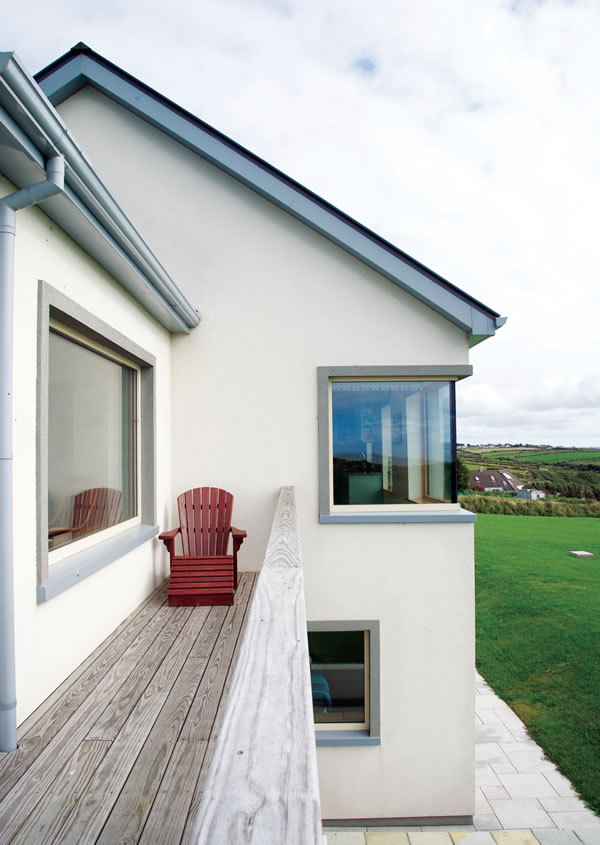
- New build
- Posted
New coastal ICF home goes passive at low costs
This house on the coast of County Waterford is built from an insulated concrete formwork shell that delivers an inherently warm and airtight construction, and easily exceeds passive house targets.
The sequence of houses in which John Carney has lived over the last thirty-five years, neatly encapsulates how house building has progressed over that time. He’s gone from a two-room cottage to a passive standard two-storey, by way of a 1990s low-energy house.
“The cottage had no running water,” says Carney, “two light-bulbs and one power point…I added a bathroom and a bedroom, and put in a septic tank, but then in 1990 we decided to build a new low-energy house and moved in around the time Mary Robinson got elected. We lived there for 25 years, and the house functioned very well, but as I became more aware of passive house, airtightness and all these things, it was almost as if I could feel the breeze more in the house.”

A quantity surveyor by profession, Carney lectures in construction management and engineering at Waterford Institute of Technology. In addition, he continues to work in the construction industry, preparing tenders for contractors and looking after the financial administration of projects. His career-long interest in sustainability brought him to conferences all over Ireland and Europe, keeping abreast of developments and making sure his students were aware of what was happening at the cutting edge of construction. He also had one eye on the day when he would put all he had learned into practice, and build his own passive house. He says: “I always thought if I was going to build, it would be great to do something like that.”
The house, which overlooks the Atlantic on the Waterford coast, has the appearance of a cottage from the front, but is in fact an inverted twostorey house. The living areas are located on the first floor with the bedrooms on the lower floor, which slots neatly into the sloping site. Carney was inspired to reduce the size of the house by a piece in this magazine by Irish Green Building Council director Pat Barry which queried whether a large passive house could be considered sustainable.

The Kingspan Aerobord foundation system consists of three layers of EPS 100 with a 400mm deep ring beam to carry ICF walls
Jeff O’Toole of Passive House Solutions is a specialist in low energy building and design, and a former pupil of Carney’s. Retained as a consultant on the build, one of his first jobs was to take the architect’s design and adapt it to passive house specifications.
“The original design was a bigger house with a lot of tricky detail on it,” he says. “There was going to be a carport on the lower ground floor, and a garage, but once I started looking at it, I realised there were loads of areas where it was going to be difficult to get thermal bridgefree construction or achieve the airtightness.”

Neopor graphite EPS forms the inner and outer layers of the ICF walls, with concrete then poured in between
This wasn’t a complete redesign, he’s keen to point out. The architect’s basic orientation and layout largely conformed to passive principles. O’Toole simplified things, putting the design through the passive house design package PHPP in order to ensure that the building fabric delivered, and to help make the house more buildable.
Carney and O’Toole spent a lot of time assessing the various building methods before settling on insulated concrete formwork, or ICF.
“ICF came into its own on the site,” says O’Toole. “Because it was split level, it had to have a retaining wall along the back, and if it was going to be any other construction type, timber frame or block wall, a concrete retaining wall would have had to go in there. Instead, John found a way of using the ICF wall as his retaining wall as well as the primary structure for his house.”
The ICF system was designed and built in Naas by Amvic Ireland. Pat Martin of Amvic says that one of the key advantages of ICF is that its advertised U-values are intrinsic to the system. “We can’t take short-cuts like not fitting insulation properly, nor can we mess with the quality of the product by not having the correct densities or properly filled moulds, otherwise the concrete would blow it apart. So once the wall is standing, it will perform.”

Siga Majpell membrane in the roof for airtightness
The standard system delivers a U value of 0.22. To get that down to the required U-value for this particular passive house of 0.15, an additional layer of insulation was added to the outside of the structure. “We used our own moulded 100mm [EPS] panel with stepped sides,” says Martin, “which means it overlaps to all its neighbours on all four sides so there’s no risk of cold bridging; they all fit perfectly against each other on the wall.”
Jeff O’Toole says that the system was “a dream” to work with. “The consistency of the insulation is the thing. It was completely continuous, plus it was very easy to add an extra layer of insulation onto the outside of it to get the U-values down.” ICF came with one other key advantage. Because of the density of the concrete mix used, the wall was naturally airtight. The blower door test result, at 0.31 air changes per hour, lies well inside the passive threshold.
All internal partitions are blockwork, in part to support the precast concrete floor slabs and in part to provide thermal mass. At foundation level, the ICF ties in with the insulated foundations, removing any thermal bridging issues here.
John Carney decided not to seek passive house certification, though the house operates well inside all of the passive targets. According to Deap, the house gets an A3 rating, and complies with everything but the minimum renewable energy contribution of 10kWh/m2/yr. (This figure is taken from the technical guidance document associated with Part L of the Irish building regs rather than the regulation itself, which only states that a “reasonable proportion” of a dwelling’s energy demand be met by renewables. Thus there is a strong case that a passive house can produce less than 10kWh/m2/yr and still comply with the law, on the proviso that a “reasonable proportion” is being generated.

Rigid ducting for the Pro Air 600 mechanical heat recovery ventilation system
Jeff O’Toole says: “John put in a 300 litre cylinder with Kingspan [solar thermal] tubes on the roof, which came in a 8kW/m2/yr, which is more than enough hot water for what John needs. There are only two people living in the house, so to meet the renewable requirement [in the technical guidance to Part L], they would have had to over-specify the solar thermal.”
John Carney has been monitoring his new passive house, but also the houses in which he lived previously — both of which he still owns. “The cottage is goose pimple-cold, especially when there’s no heat on. The temperature gets down to 7C inside in the house. The middle house, the one built in 1990, is around 12C and the passive house is about 17C, and that’s over a period of time when all the houses were unoccupied and unheated.”
Carney also kept close tabs on the budget throughout the project, which ran from October 2012 to November 2013. Total spend per square metre was €1,225 inclusive of Vat, and that includes everything, from local authority contributions to the tarmac driveway, entrance gates, dry-stone walls, landscaping, rainwater harvesting and the sewerage treatment facility.

“The house itself was a wonderful experiment,” says John Carney. “Someone said to me, it was an expensive experiment but it wasn’t expensive, it was a very worthwhile exercise. I had the site, I had the planning permission, I had the water supply right onsite, I had a little bit of expertise in construction, and I got tremendous mileage out of it from a teaching point of view.”

SELECTED PROJECT DETAILS
Client, project manager & QS: John Carney
M&E engineer: Dick Power
Passive house & airtightness consultant:
Passive House Builders
MVHR: ProAir Systems
Electrical contractor: Chris Orpen
Insulated concrete formwork: Amvic Ireland
Roof insulation: Knauf
Insulated foundation system: Kingspan Aerobord
Airtightness products: Siga
Windows and doors: Munster Joinery
External rendering: DMC Plastering
Fit out & furniture: DFL Joinery
Groundworks, drainage & substructure:
Power Ground Works
Additional info
Building type: 245 square metre detached split level two storey ICF house
Location: Dunmore East, Co Waterford
Completion date: May 2015
Budget: €300,000 total cost excluding site purchase, but including Vat, council levies, self-build insurance & external works.
Passive house certification: Uncertified
Space heating demand (PHPP): 8 kWh/m2/yr
Heat load (PHPP): 10 W/m2
Primary energy demand (PHPP): 109 kWh/m2/yr
Airtightness: 0.33 ACH at 50 Pa or 0.4 m3/m2/hr at 50 Pa
Energy performance coefficient (EPC): 0.37
Carbon performance coefficient (CPC): 0.385
BER: A3
Thermal bridging: Kingspan Aerobord foundation system, Amvic insulated concrete formwork. All junctions as per Amvic ICF thermal bridge-free details, thermally broken
window frames, Calculated Y Value: 0.001 W/mK
Ground floor: Kingspan Aerobord foundation system consisting of three layers of EPS 100 with 400mm deep ring beam to carry ICF. U-Value: 0.10 W/m2K
Walls: Weber external render on 100mm Neopor graphite EPS insulation mechanically fixed to Amvic ICF system, comprising 63mm Neopor graphite EPS, 150mm concrete core (200mm core on retaining walls), 63mm Neopor EPS, finished inside with 15mm Gypsum Rigidur boards on 15mm metal top hat. U-value: 0.13 W/m2K
Roof: Tegral Thrutone fibre cement slates externally on 50x35 battens/counter battens, followed underneath by breathable bitumen impregnated sarking board, 500mm timber attic truss fully filled with Knauf Earthwool Insulation, 15mm taped & sealed OSB, 50mm uninsulated service cavity, 12.5mm plasterboard ceiling. U-value: 0.10 W/m2K
Windows: Munster Joinery triple-glazed argon filled Passiv aluclad windows. Overall U-value: 0.79 W/m2K
Heating: One electric storage heater set on night rate electricity in the centre of the house. Dimplex electric fire plus electric panel heaters in the bedrooms. Electric Devi matts in the bathrooms. 30 Kingspan Thermomax solar vacuum tubes supplying separate 300 litre domestic hot water tank.
Ventilation: ProAir Systems PA 600 mechanical ventilation with heat recovery system with rigid ducting
Image gallery
Passive House Plus digital subscribers can view an exclusive image gallery for this article. Click here to view





